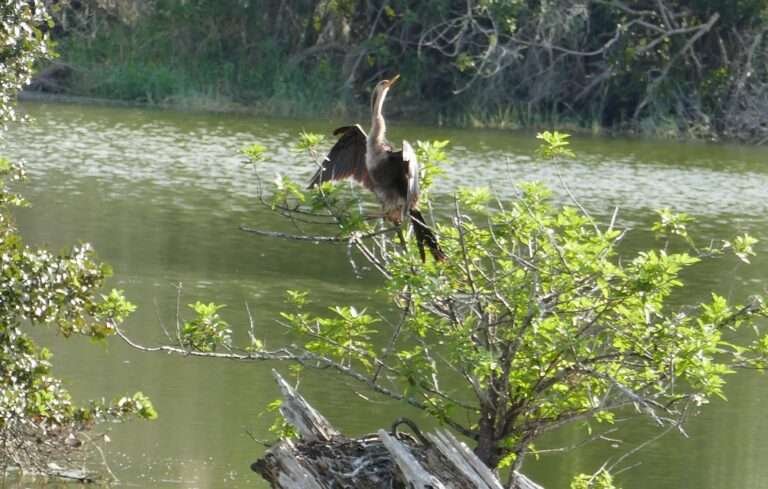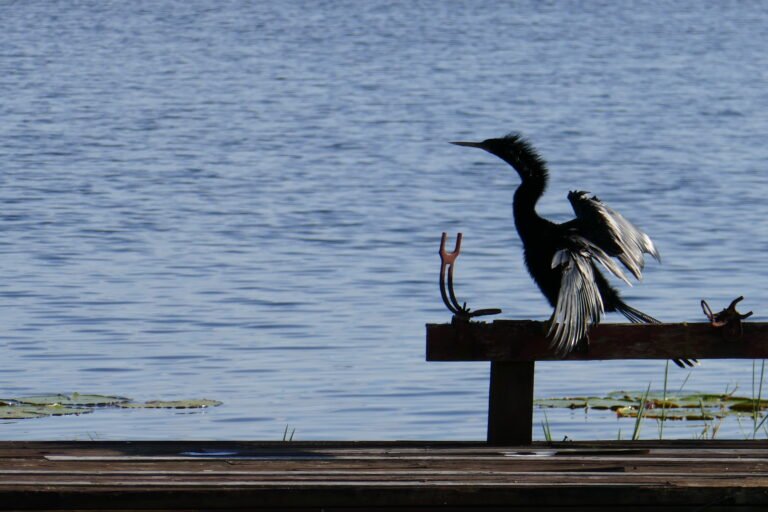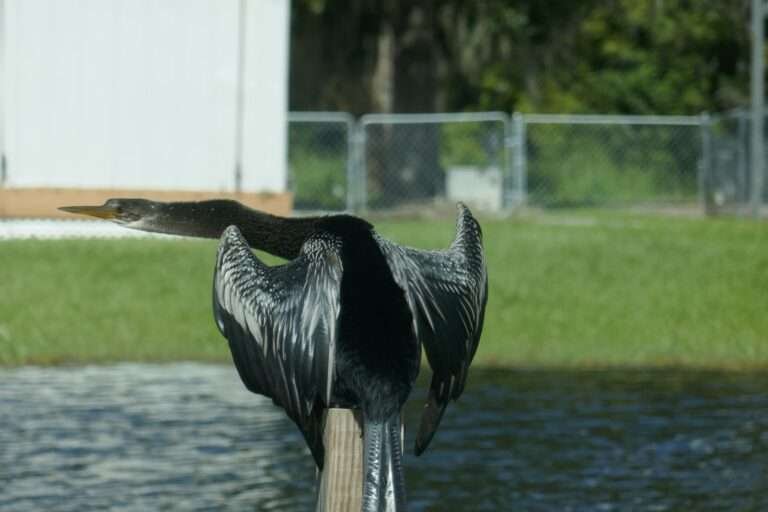
Anhinga anhinga
(Anhinga)

Description
Anhingas are large water birds that are about 35 inches in length with a wing span of about 45 inches.
They have long slender necks and very sharply pointed bills (used for spearing fish).
They have short stubby legs with large webbed feet.
The males are jet black with the appearance of a green glossy finish to their feathers. They have white spots and streaks on their wings and upper backs. During breeding season the males face becomes brightly colored with shades of turquoise.
The females are a brown, buff, color on their necks and chests. With white spots on their wings.
Immature birds resemble the older adults, but overall are browner in color.
Common Names and Latin Name
Snakebird, water turkey, devil bird and American darter.
The word anhinga comes from the Brazilian Tupi language “a’ninga” which means devil bird.
Anhinga anhinga

Family
Anhingas are found in the Anhingidae, or darter, family. Their scientific name is Anhinga anhinga.
Darters spear their prey with sharp, slender, beaks. Anhingas are the only bird in this family.
The others include: African Darter (Anhinga rufa), Australian Darter (Anhinga novaehollandiae), and the Oriental Darter (Anhinga melanogaster). [1]
Behavior
The anhinga is a large water bird found in Florida year round. It is sometimes called the snakebird because when it is swimming, and fishing, the head and neck are the only visible portions of the bird and it looks like a snake swimming through the water. They are sometimes confused with cormorants because the behavior and habitat are similar.
However, anhingas are found in the Anhingidae, or darter, family. Cormorants are found in the Phalacrocoracidae family.

Habitat
The anhinga’s preferred habitat is sheltered, slow moving, mostly, fresh waters such as lakes shores and streams, however, they do inhabit tree covered islands and coastal bays.
They establish territories with convenient perching areas to intermittently dry and preen in between fishing for food. The perching areas are generally docks or other large structures because these birds are rather big and heavy and need stout perches.
Range
Anhingas lack insulating feathers so have to constantly dry their wings in the sun which is why they are usually found with their wings spread open to the sunshine. The lack of insulating feathers actually allows them to dive better because they have less buoyancy.
Coupled with their low metabolism, the anhinga’s lack of insulating feathers limits the northernmost extent of their range to the southeastern United States (North Carolina (and south) and westward to Texas.
While anhingas range widely to the south to take advantage of the warmer temperatures offered by South America, double-crested cormorants range to the colder climates of the north, all the way to Alaska. [2]
Food
Anhingids feed primarily on fish, but they will also prey on amphibians (salamanders, frogs, newts), reptiles (snakes, baby alligators, turtles), and invertebrates (insects, leeches, mollusks, crayfish, shrimp). [3]
I have not found any literature that verifies they throw up pellets, but my video certainly shows one doing so. I have been finding pellets on my dock and thought it was the barred owls, but I believe it’s the anhinga. The undigestible bits are thrown up by the bird. Just before it happens they start to pant and act uncomfortable by opening and closing their beak and stretching their neck. Similar to a cat throwing up a hair ball.

Nesting and Young
Male anhingas gather the nesting material, and females construct the nest by weaving sticks together and padding it with live twigs and green leaves. Anhingas are monogamous and pairs may reuse the same nest from year to year. [4]
The female lays 2 to 6 pale blue eggs. Both parents incubate the eggs for 25 to 30 days. The young hatch altricial and are incapable of moving around on their own to find food (unlike ducklings which are precocial and can feed themselves).
The chicks stay in the nest for about three weeks during which time the parents feed them, at first through regurgitation, and eventually with the chicks sticking their heads into the parents bills to reach the food.
The chicks begin to climb out of the nest, and explore, at about three weeks of age. By six weeks they are fledging and leaving the nest. Anhingas reach sexual maturity at 2 years of age.

